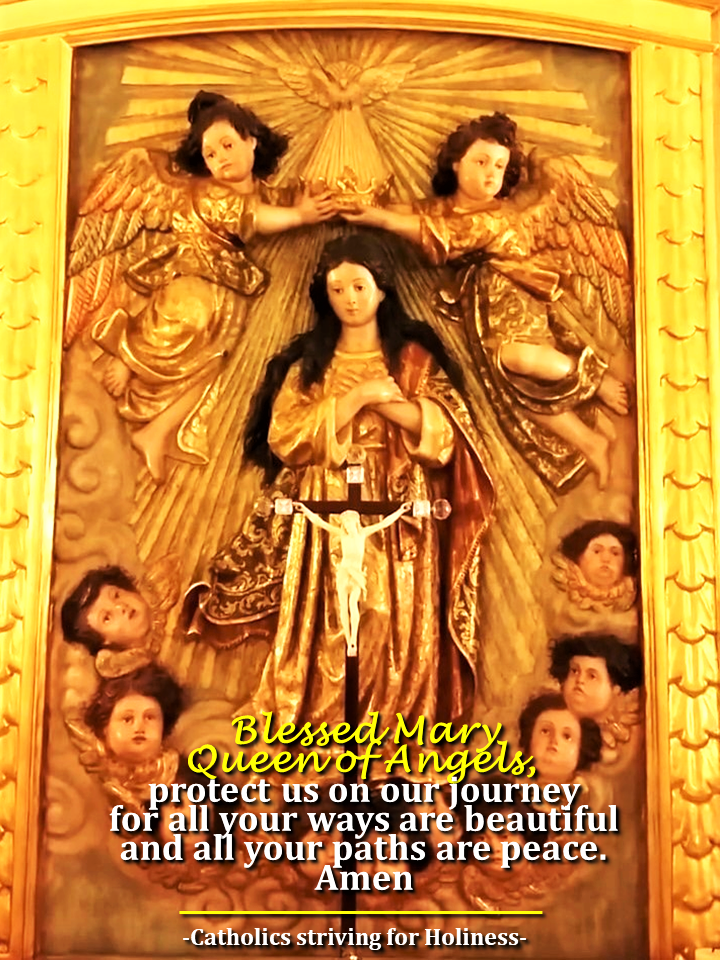AUGUST 2: OUR LADY OF THE ANGELS. HISTORY OF THE DEVOTION.
The Porciuncula in Assisi is best known to us for its association with St. Francis, it had a remarkable history long before the “Poor Man of Assisi” was born. It is first mentioned in the year 1045, when it was called the Chapel of Our Lady of the Angels; the locals had heard Angels singing there, and immediately thought of the Assumption. It was in time given to a Benedictine Monastery, whose Abbot gave it to St. Francis to repair, in accordance with a dream the Saint had had. It was inside the little building that St. Francis had the vision of Christ wherein was revealed the Porciuncula Indulgence — the annual practice whereby the Faithful may gain a plenary indulgence under the usual conditions by visiting a church on August 2, the feast of Our Lady of the Angels. Originally restricted to visiting the Porciuncula itself on that day, successive Popes gradually extended the privilege to all Franciscan churches, to all parish churches, and finally to any church whatsoever. Today the Porciuncula is tucked away inside the much larger and splendid Basilica of Santa Maria degli Angeli, built around the little chapel by order of St. Pius V — himself no stranger to miracles.
Indeed, many churches under this dedication have been accompanied by wonders and marvels. In Rome itself, the Basilica of Santa Maria degli Angeli e dei Martiri (…”of the Angels and Martyrs”) is best known as the Church of the Italian Royal Family and of the State as well, where various important religious ceremonies are performed. But its origins lie in the determination of the 16th century Sicilian Priest, Antonio Lo Duca. Fr. Lo Duca received several visions of angels, and conceived of the notion of building a church in honor of the Seven Archangels amid the ruins of the Baths of Diocletian. Despite the favor of the Emperor Charles V, his attempts to interest a succession of Popes in the project failed — until Pius IV commissioned Michelangelo to design the new building.

A century later, near the town of Lurs, in Provence, villagers reported hearing angelic choirs as well as an apparition of the Virgin. The shrine was approved by the diocese for pilgrimages, and miraculous cures began. Despite the upheaval of the French Revolution, these have continued until the present.
Thirty five years earlier, in 1625, a poor woman of Cartago, in Costa Rica, discovered a small statue of the Virgin sitting on a rock in the midst of the thicket where she usually gathered firewood: it was August 2, the feast of St. Mary of the Angels. Impressed by her find, she took the image home and put it in a box. Going back for more wood at Noon, she found to her amazement an identical statue on the rock. She rushed home, only to find that the box was empty; she locked up the image once more. A third visit found the image returned to the rock, and the box at home just as empty. Frightened, she brought the image to the parish priest, who locked it up in the rectory, saying he would examine it more closely when he had the time. All to no avail! The image was back on the rock when the woman returned. This time she summoned the priest and various neighbors — forming an impromptu procession, they brought the statue back to the parish church, whereon the priest locked the statue up in the tabernacle on the altar. Yet it returned, at which priest and people realized that the Virgin wanted to stay there. The townsfolk built a chapel on the spot. In time, successively larger ones would be erected, until at last the current one, the national Marian shrine of Costa Rica, stands guard over the little statue. Here in Los Angeles, the local Costa Rican community honors Nuestra Senora de los Angeles with a procession.
CSFH PHOTO
EXCERPT FROM http://www.thequeenofangels.com/mary-the-queen/our-lady-of-the-angels/
Stay updated: subscribe by email for free TO OUR NEW WEBSITE www.catholicsstrivingforholiness.org (PUT YOUR EMAIL IN THE SUBSCRIBE WIDGET).
We are also in www.fb.com/Catholicsstrivingforholiness. Kindly help more people in their Christian life by liking our page and inviting your family, friends and relatives to do so as well. Thanks in advance and God bless you and your loved ones! Fr. Rolly Arjonillo


